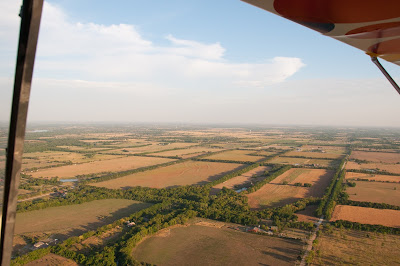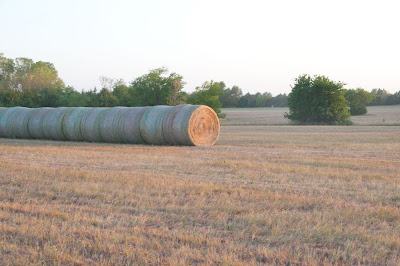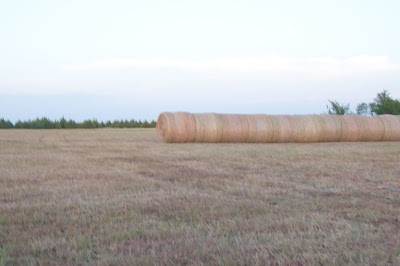Please note: James' blog has moved to a Wordpress site. To access it, please visit
http://jameswiebe.wordpress.com/. All posts have been transferred to the new site, and all new posts will only be accessible via Wordpress. Thank you for your interest!
Descending on Alfalfa Final
By James Wiebe (c) 2012
The takeoff roll was uneventful. Another takeoff in front of a small crowd at Oshkosh 2012 -- ultralight field. The WoW plane climbed from the very short field, and displayed its balloon colors. I was satisfied. I was contemplative. It was a beautiful morning, and I was pleased to be part of it.
A momentary burble, like a tiny firecracker, hit the ignition cycle, and I felt it, and those neurons in my head responsible for verifying my personal safety fired a signal to other parts of my brain:
"You are not safe. Your engine is not running smoothly."
I was perhaps 80 feet above the runway, but absolutely nothing left in front of me, and I needed to make an immediate right turn to enter the pattern. I did so, and began hoping that the engine would smooth.
The plane continued to ably climb, enough that I gained momentary confidence to contemplate going around the pattern with a misfiring engine.
I made it to the oak tree in the middle of the pasture to the south, and I crossed it approach my pattern altitude, which is 300 feet.
But as I passed over the oak tree, the engine burbling continued. I could hear the RPM drop, and the ignition misses became more urgent. It was as if I was listening to a scale of descending notes, with each note just a fraction of a hertz below the last. It was as if I could see a wave of piano keys, with consecutively keys being struck, lower and lower, and I knew the keyboard ended somewhere, but I couldn't tell quite where. What could I do to make the keys go up? And every so often, an odd key was struck in the midst of the hertz scale descent. Weird. Weird Weird.
I was scanning left and right for landing spots. Lots of fields with heavy green crops. Trees. A farm house. A regular house. Roads.
I ran scenarios through my head:
Reversing course 180 degrees to return to the ultralight field: bad idea. Too much congestion. Too short a field for an emergency landing.
Sputtering around the pattern: bad idea. Corn fields with six+ foot stalks. Campers. Narrow emergency runways. Might not make it arround. Probably wouldn't make it around.
I was now over a closely mowed alfalfa field. I knew my options ahead were very poor, and I did not like the odds of sputtering around the pattern.
Another set of neurons fired in my brain, and they made a very simple statement:
"Your engine will fail within 2 or 3 minutes. It is likely that the engine will run out of power before you make it back to the airport. You are given permission to make unusual choices. Please make a wise choice."
I looked back at the alfalfa field. It was no longer a 40 acre patch of rolling, mowed alfalfa. Instead, it was a huge beacon of safety. It yelled up at me ---------
"JAMES!!!! You are safe here!!!! Please come here!!!!"
A moment later, I pulled the throttle back to idle, turned left to enter short final for alfalfa, and about 20 seconds later my wheels touched down. I applied the brakes and taxied across the field to be closer to a driveway. The engine made more misbehaving sounds as I taxied. I shut it off.
--------------------------------------------------
Most of the rest of this story is just details. I think the one detail you want to know is: what went wrong with the engine? As of this writing, I don't know. It appeared to be an ignition problem, which could have been caused by a broken timing pickup. The engine was nearly brand new, so it falls under some form of infant mortality. It could also have been some oil contamination in the ignition.
 |
| Belite Ultralight Aircraft, after precautionary landing in alfalfa field |
Of course, I got out of the airplane. I then sent my wife a text message that I was OK, and so was the plane. Later I found out that when she got the text, she was surprised, not even aware I was flying.
So many people saw the plane make this emergency landing, I figured that a plethora of emergency vehicles would soon show up. Surprisingly, none did. The Ultralight Air Ops showed up, and they were thrilled with the outcome. They took a few notes, called EAA Ops, and got clearance to move the plane: no damage to the plane, pilot, or property. The property owner had even come out of her nearby house, and was pleased that no one was hurt. She returned to her house.
I talked to my wife on the phone, and had her send the guys and the big Penske truck (we later changed our mind and got my pickup truck instead.)
I folded the wings on the plane while I waited for them to show up.
 |
| Belite Ultralight Aircraft with wings folded, in alfalfa field. |
They did show up, and we quickly determined the pickup truck would be more useful for hauling the plane back. So while Wayne and Christian drove off in the Penske truck, in order to swap for the pickup truck, it started to rain. I pulled the plane onto the driveway, got in the plane and took pictures of the passing traffic.
 |
| Passing traffic and left knee of James Wiebe from cockpit of Belite Ultralight Aircraft |
Even more bored, I took a picture of myself.
 |
| James Wiebe, self portrait |
And finally the guys returned with the pickup truck.
 |
| My pickup shows up. |
We put the tailwheel of the plane on the tailgate, and slowly pulled the plane backwards back to the ultralight field.
----------------------------------------
Some things to learn from this adventure:
A) preflight. I'm bugged that I might have missed something. I had some leakage from the head -- oil causing an ignition problem?
B) look for an 'out' at the first sign of trouble.
C) take the 'out' as soon as it identifies itself to you.
D) don't worry about what others might think. I was concerned about the 'shame' of not making it around the pattern. I was also concerned about the 'shame' of having an engine failure or off-field landing, as it might 'hurt' the Belite reputation. I've seen video of some guy flying upslope into a mountain, instead of turning around and admitting a mistake.
I already knew that I had made the right decision as I was in my airplane, descending on Alfalfa final.
August 1, 2012 Addendum:
The cause of all the trouble was a leaking head gasket, caused by loose head bolts. The head bolts were in the manufacturer's list of bolts to torque in the first 1 and after 10 hours, which I had not done. The fault was all mine. I will never make this mistake again. -- James






























